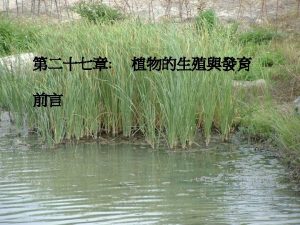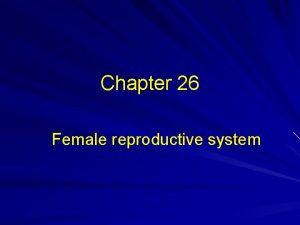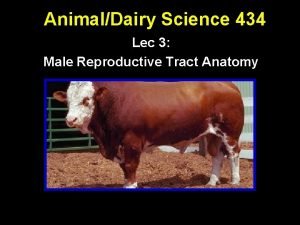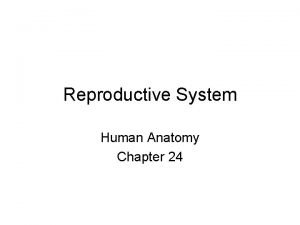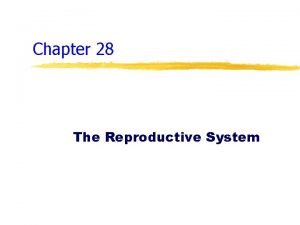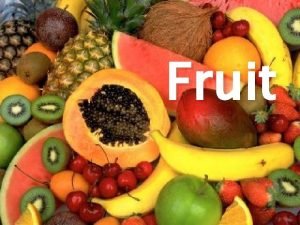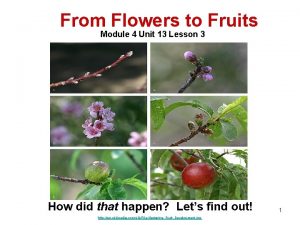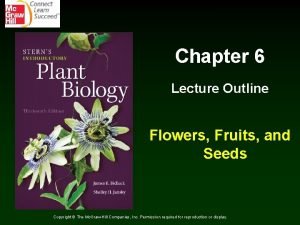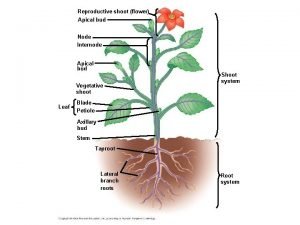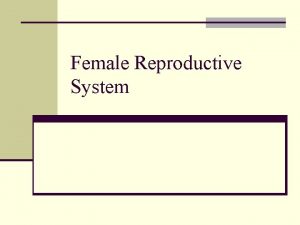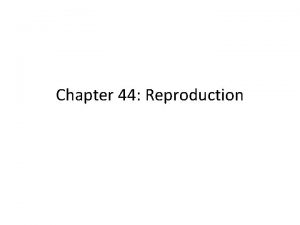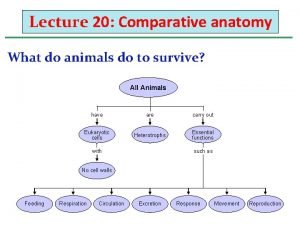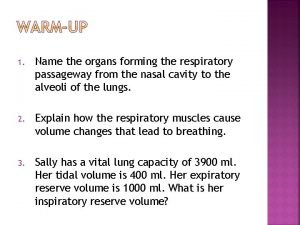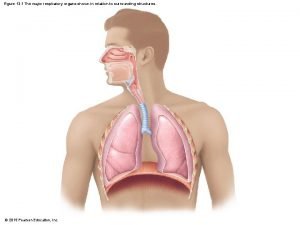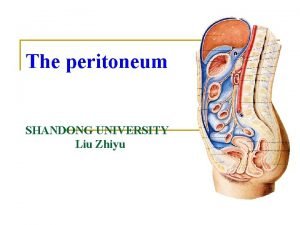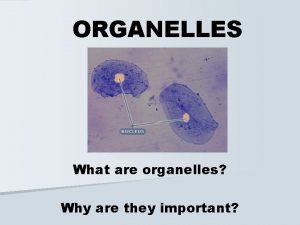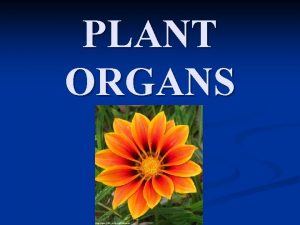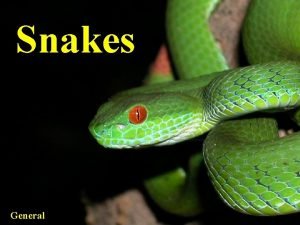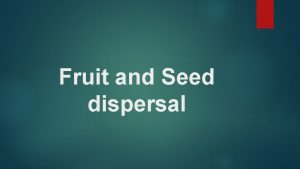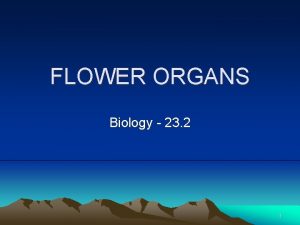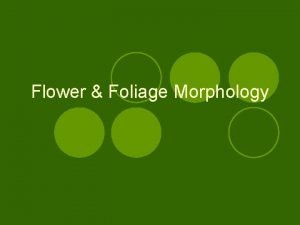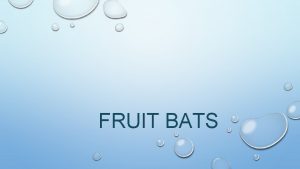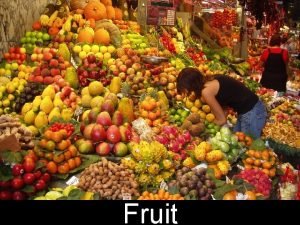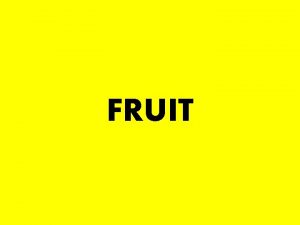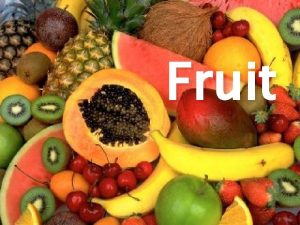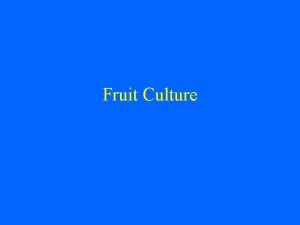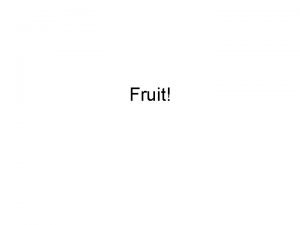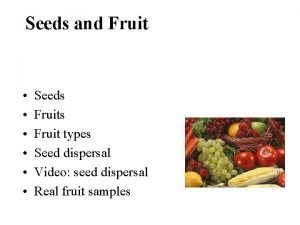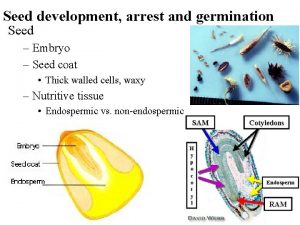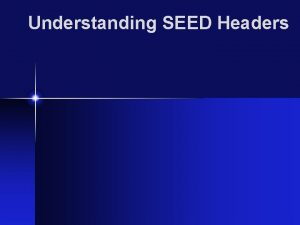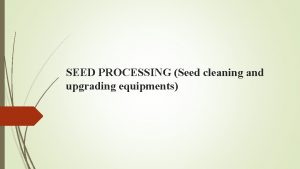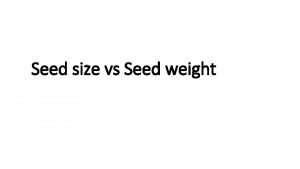Reproductive organs flower fruit seed Flower reproductive structures






































- Slides: 38

Reproductive organs - flower, fruit, seed

Flower • reproductive structures, found only in flowering plants (Angiosperms) • basic structure to distinguish plant families • defined as highly condensed and modified reproductive shoot Function: • to effect reproduction - continuation of the species; • to protect organs for sex reproduction; • to attract pollinators • to give rise to fruit and seeds

Flower terminology: • Bract - a modified or specialized leaf, associated with a flowers or inflorescens • Pedicel - short or long flower stalk • Thalamus (Receptacle) - upper part of pedicel (swollen, spherical shaped or conical) • Pedicellate flower - flower with pedicel (A) • Sessile flower - flower without pedicel (B) A B

Flower parts : • Vegetative (sterile) - consist of petals and sepals • Reproductive (fertile) - consist of pistil and stamens (essential part of the flower)

Vegetative (sterile) part of the flower – Calix & Corolla Calyx - the outermost whorl, consisting of units called sepals. These are typically green and enclose the rest of the flower in the bud stage, however, they can be absent or prominent and petal-like in some species. Corolla - the second whorl of the flower, composed of units called petals, which are typically thin, soft and highly colored to attract insects for pollination. Perianth - consists of sepals and petals , that are different in shape & color (apple). Tepal - consists of sepals and petals, which do not differ from one another (tulip) Corolla shapes - usually are the showy part of the flower. The petals in corolla may be fused or free. In fused corollas, any extension of the petal beyond its fused part is called the limb. The tube like structure where the petals are united at the bottom of the fused corollas is called the tube. The opening at the top of the tube in fused corollas is called the throat.

Corolla shapes: Rotate: wheel-shaped with a short tube and large limb (example: bluets). Campanulate: bell-shaped with an extended, flaring tube (example: bellflower). Funnelform: funnel-shaped with a continuously expanding tube and little flaring (example: bindweeds). Tubular: an elongated tube with minimal limb (example: trumpet vine). Salverform: an elongated tube with a conspicuous limb, trumpet-shaped (examples: Russian olive, morning glory). Urceolate: an inflated tube with a terminal constriction, urn-shaped (example: highbush blueberry). Bilabiate: two-lipped, usually because of the presence of a landing platformed by basal lobes (examples: snapdragon, salvia). Ligulate: petals connate at the margins to form a strap-shaped corolla (example: asters). Papilionaceous: like a butterfly with a central standard petal and lateral wing petal (example: lupines). Flower terminology: Fused and Distinct Floral Parts Flower terminology The floral parts may be free or united. Conation floral parts - fusion of like parts (such as petals united to petals) Distinct floral parts - when like parts are not fused, they are said to be distinct (one petal is distinct from another petal). Adnation - fusion of unlike parts (stamens united to petals) Free floral parts - stamens are free from petals * Fused structures may be united from the moment of origin on ward, or they may initially be separate and grow together as one later in development.

Reproductive (fertile) part of the flower - Stamens & Pistil Stamen - collectively called Androecium are the male sexual organ of the flower. A stamen consists of an anther which contains the pollen, supported by a thin filament. When the pollen becomes mature, it is released through the ruptured anther wall. Pistil - pistils, which are oftenly called carpels, (collectively called Gynoecium) are the female sexual organ of the flower which are usually vase-like in appearance. A carpel usually consists of three flower parts: the stigma, style and ovary. The stigma is an enlarged tip of the carpel which serves as a “landing pad” to receive the pollen in the process of pollination. This part of the flower is supported by a slender stalk (the style) which is connected to an enlarged base (the ovary) which contains the ovule. The ovule is borne on a surface called placenta. Pistil - 2 types: Simple pistil - has a single reproductive unit called a carpel (strawberry) Compound pistil - has two or more carpels, often fused (grape) After pollination and fertilization, the ovary develops into a fruit and the ovule into a seed.

Flower terminology: Apocarpous and syncarpous gynoecium Flower terminology The gynoecium may be monocarpellary or multicarpellary. If only one carpel is present in gynoecium this condition is called monocarpellary. �� If more than one carpel is present in gynoecium this condition is called polycarpellary. �� If all the carpels in polycarpellary / multicarpellary condition are free, then condition is called apocarpous. �� If all the carpels are fused together, then condition is called syncarpous.

Flower terminology: Placentation Flower terminology The ovules are attached on ovary walls on one or more cushion called placenta. The arrangement of ovulewithin ovary wall is known as placentation. It is of following types : �� Marginal : Marginal placentation is found in unilocular ovary. The placenta forms a ridge along the ventral suture of the ovary and the ovules are borne on this ridge forming two rows. eg. Leguminosae. �� Parietal : This type of placentation is found in unilocular syncarpus ovary. In it the ovule develops on the innerwall of the ovary or on peripheral part. Ovary become bi or multilocular due to formation a false septum eg. Cucurbita, Argemone, and Cruciferae family (Mustard) �� Axile : It is found in multicarpellary syncarpous gynoecium. The fusion margin of carpels grown inward and meet in the centre of the ovary. Thus an axis forms in the centre of ovary, thus ovary becomes multichambered. The ovules are born at the central axis. Number of these chambers are equal to the number of carpel eg. Potato, China rose, Onion, Lemon, Orange, Tomato. �� Free central : This type of placentation is found in syncarpous gynoecium. In it, the ovary is unilocular and the ovules are borne on the axis in the centre of the ovary. septum are absent in ovary. Placentation is axile in beginning. After sometimes walls of chamber destroy and only ovulated central axis left. eg. Primrose, Dianthus (Caryophyllaceae) �� Superficial: This type of placentation is found in multicarpellary syncarpous gynoecium. The ovules are attached on the walls of locule eg. Nymphea (Water lily) �� Basal : The ovary is unilocular and a single ovule is borne at the base of ovary. eg. Marigold, Sunflower (Asteraceae family)

Flower types: I. According to the number of floral parts (Flowers in Monocots and Dicots) flowers are: • In type 5 (4) = flower parts usually occur in fours or fives or multiples of four or five (Dicots) • In type 3 - the flower parts occur in threes or multiples of three; for example, three sepals, three petals, six stamens, and a pistil with three carpels (Monocots)

II. According to the presence or absence of the different parts of a flower - complete and Incomplete flowers • Complete flower - if all four floral whorls (sepal, petal, stamen and pistil) are present in the same flower structure (Hibiscus rosa-sinensis - gumamela or China rose) (A). • Incomplete flower - lacks any one or more of these parts. The flowers of Americam elm (Ulmus americana) are mainly wind-pollinated and are incomplete, lacking both sepals and petals. Relying on wind to accomplish pollination, there is no need for these organs to attract pollinators (B). A B

III. According to the presence or absence of reproductive organs on the flower and their placement on the floral base - perfect and imperfect flowers placement on the floral base • Perfect (bisexual, hermaphrodite) - flowers that contain both sexual flower parts (stamen and pistil). • Imperfect (unisexual) - that contain either stamen or pistil only (regardless of whether they lack sepals or petals). • The separation of the male and female sexual organs increases the possibility of outcrossing or cross pollination.

!! In case that the flower is imperfect, there are two variants: • Monoecious plant - when staminate (male) and pistillate (female) flowers occur on the same plant, (Eg. corn, walnut tree). • Dioecious plant - when male and female flowers are borne on separate plants (Eg. asparagus, willow).

IV. According to the position of ovary - flowers with superior or inferior ovaries • Flower with superior ovary - when the base of the ovary is located above where the sepals, petals, and stamens are attached. This point of attachment is referred to as the receptacle or hypanthium, the fused bases of the three floral parts (tulips and St. John’s wort are examples). • Flower with inferior ovary - has an ovary below where the sepals, petals, and stamens are attached (as do daffodils and sabatia). * Some flowers show an intermediate type, where the receptacle partly surrounds the ovary; the petals and stamens branch from the receptacle about halfway up the ovary (as in cherry, peach, and almond flowers).

Flower terminology: The thalamus is the swollen tip of a pedicle or the floral axis on which the floral whorls are developed in a cyclic manner. On the basis of shape of thalamus angiospermic flower can be categorized into three types: • Hypogynous - In this type thalamus is swollen at the topmost position of which lies the ovary and other floral parts arise below the ovary on the thalamus so that the position of ovary becomes superior and other floral parts become inferior. Eg: Brassica, Solanum. • Perigynous - Here thalamus is cup-shaped in which ovary lies at the central position and other floral parts arise around the ovary on the rim of the thalamus. Due to this the position of ovary becomes semi-inferior and other floral parts superior in nature. Eg: Rose • Epigynous - Here thalamus is cup-shaped with a deep cavity which encloses the ovary and other floral parts arise above the ovary on the thalamus so that the ovary becomes inferior and other floral parts superior in nature. Eg: Tagetes

V. According to the flower symmetry - Regular and Irregular flowers V. According to the flower symmetry • Rregular flowers (with radial symmetry - actinomorphic ) - when the petals and sepals are similar of shape. In these cases, any line drawn through the center of the flower will divide it into two similar halves. The halves are either exact duplicates or mirror images of each other. Flowers with radial symmetry are also called actinomorphic flowers (Eg. : stonecrop, morning glory). • Irregular flowers (with bilateral symmetry – zygomorphic) - have parts, that are different in shape, and arranged in such a wayр that only one line can divide the flower into equal halves that are more or less mirror images of each other. Flowers with bilateral symmetry are also called zygomorphic flowers (Eg. : mint, pea, snapdragon).

Inflorescence - a group or cluster of flowers arranged on a stem that is composed of a main branch or a complicated arrangement of branches. Inflorescence terminology: The stem holding the whole inflorescence is called a peduncle and the major axis, holding the flowers or more branches within the inflorescence is called the rachis. The stalk of each single flower is called a pedicel, which is differ to a peduncle - a stalk of solitary flower, and any flower in an inflorescence is define as a floret. Any leaf associated with an inflorescence is called a bract and is usually located at the nodes.

Inflorescence types: • Indeterminate (racemose, monopodial) inflorescence - the peduncle never ends in a flower, but it continues to grow indefinitely and bears flowers laterally in acropetal succession i. e. , the younger flowers develop towards growing end while the older flowers grow at the base. • Determinate (cymose, sympodial) inflorescence - the growth of peduncle is limited as it ends in a flower and the subsequent lateral axis also ends in a flower. Further, flowers borne in basipetal succession i. e. , the older flowers are towards apex and younger towards base.

• Indeterminate inflorescence types: raceme, panicle, spike, catkin, corymb, umbel, spadix, or head Indeterminate inflorescence types: Racemose inflorescenses - In this type of inflorescence the main axis continues to grow and does not terminate in a flower and give off flower laterally in acropetal manner where old flowers are arranged toward base and young flowers are at tip. �� Raceme - when peduncle (main axis) is elongated and flowers are pedicellate. eg. Radish, characteristic feature of Cruciferae family. When peduncle is branched and each branch bear pedicellated flowers like racemose and are arranged inacropetal manner known as compound raceme or panicle. Eg. Gulmohar, Neem. �� Spike - In it peduncle is elongated but flowers are bisexual and sessile Eg. Achyranthes. When peduncle is branched and each branch bear spike, like inflorescence then the small branch having flower is called spikelet and this arrangement is called as spike of spikelet. Characteristic inflorescence of family gramineae. �� Catkin - In it peduncle is thin, long and weak, and flowers are sessile and unisexual. mulberry, betula, oak. �� Spadix - In it peduncle is thick, long and fleshy and have small sessile and unisexual male and female flowers covered with one or more green or colourfull bracts known as spathe. eg. Colocasia, Maize, Aroids, Palms. �� Corymb - In it peduncle is short and all flowers are present at same level because the lower flower has much long pedicel than the upper one eg. Candytuft (Iberis amara). If in this type of inflorescene peduncle is branched, then each branch has flower cluster then this type of inflorescence is called compound corymb. eg. Cauliflower. In mustard corymbose raceme type of inflorescence is present �� Umbel - An inflorescence in which the flower stalks of different flowers are of more or less equal length, arise from the same point. At the base of flowers stalks, there is whorl of bracts forming the involucre. eg. Centella If in this type of inflorescence, peduncle is branched then each branch has flower cluster then this type of inflorescence is called compound umbel. eg. Coriander, Foeniculum, Cuminum. Characteristic feature of Umbeliferae family. �� Capitulum / Racemose head - In it the growth of peduncle is retarded and it become broad, flattened concave or convex. On it small flowers are found. These flowers are called floret. If all the flower of capitulum are same , then it is called homogamous. If two different type of floret, ray floret and disc floret are present in same inflorescence than it is known as heterogamous. In this type of inflorescence florets may be unisexual, bisexual and sterile. This inflorescence is surrounded by one or more involucre. It is most advanced type of inflorescence. eg. Sunflower, Zinnia, Marigold, Cosmos.


• Determinate (Cymose) inflorescense types - in this type of inflorescence, the peduncle ) inflorescense types terminate in a flower. In it the older flowers are present at tip and young buds are arranged towards base. This arrangement is called basipetal succession. It is of following types: �� Uniparous cyme / Monochasial cyme - The peduncle ending in a flower producing lateral branch at a time of ending in flower. It is of two types �� Helicoid cyme - When all lateral branches developed on the same side on peduncle then it is called helicoid cyme. eg. Heliotropium, Saraca, Atropa, Datura. �� Scorpioid cyme - In it the lateral branch is alternately develop on left and right side. eg. Bignonia. �� Dichasial or biparous cyme – In it peduncle ends in a flower, from the basal part of peduncle two lateral branches arise, which also end in a flower, now this same arrangement occur on these lateral branches. eg. Bougainvillea, Jasmine, Teak, Mirabilis, Dianthus, Nyctanthes. �� Multiparous cyme / polychasial - In it peduncle ends in a flower and from the base of it many lateral branches arise which also terminates in flower, this arrangement now also occur on these lateral branches. eg. Calotropis (Madar), Nerium, Asclepias, Hamelia


Fruit


Fruit formation: • ovule becomes the seed • ovary becomes the fruit

Fertilized and ripened ovary is a fruit. Fruit parts : (i) Pericarp (fruit wall), (ii) seed Pericarp : After ripening, the ovary wall change into pericarp. This pericarp may by thick and fleshy or thick and hard or thin and soft. Pericarp is differentiated in 3 layers �� Exocarp - the outermost layer, which is also called rind �� Mesocarp - the middle layer. �� Endocarp - It forms the innermost layer. TRUE FRUIT : When the fruit is developed only from the ovary, the fruit is called as true fruit. eg. Mango, Coconut, Zizyphus FALSE FRUIT OR PSEUDOCARP : In some fruits, in place of ovary, some other parts of flower like thalamus, inflorescence, calyx are modified to form a part of fruit. These types of fruit are called false fruits. eg. Apple, Strawberry, Pear.

CLASSIFICATION OF FRUIT Fruits are divided in three groups ✧ Simple ✧ Aggregate ✧ Composite I. Simple Fruits - Fruits formed from 1 pistil. They may be either true or accessory fruits. I. Simple Fruits A. Dry Fruits: - Fruits in which the coat becomes dry at maturity. A. Dry Fruits: 1. Dehiscent Fruits - Dry fruits which at maturity open by definite natural means to shed the Dehiscent Fruits - contained seeds. i. Legume - a dry dehiscent fruit developed from 1 carpel and at maturity splitting along both the dorsal and ventral sutures (beans, peas). ii. Follicle - a dry dehiscent fruit developed from 1 carpel and at maturity splitting along only one suture (larkspur, columbine) iii. Capsule - a dry dehiscent fruit developed from several carpels. (a) Loculicidal capsule - one which splits along the outer median line. (lilies). Loculicidal capsule (b) Septicidal capsule - one which splits along the septa and opens at the top. Septicidal capsule (yucca, agave). (c) Silique - a special long slender capsule of 2 carpels. (mustards). Silique (d) Silicle - a special short broad capsule of 2 carpels. (mustards). (e) Pyxis - a capsule which has circumscissle dehiscence. (plantain, amaranths, Pyxis purslane). (f) Poricidal capsule - one which opens with round holes. (poppies). Poricidal capsule


2. Indehiscent fruits - Dry fruits which do not open when mature to shed their seeds. 2. Indehiscent fruits Many of this group are one seeded fruits. • Achene - A one-seeded, dry, indehiscent fruit; the one seed is attached to the fruit Achene wall at a single point. (buttercups, dandelion, sunflower). • Nut - A dry, indehiscent, one seeded fruit similar to an achene but with the wall Nut greatly thickened and hardened. (beech, chestnut, oak, hazel; walnut and hickory - note: because of extra floral bracts, or "husk", the latter two fruits are sometimes called "drupes"). • Samara - A one- or two-seeded dry, indehiscent fruit in which part of the fruit wall Samara grows out into a wing. (elm, maple, ash). • Grain - A one-seeded dry, indehiscent fruit in which the fruit wall and the seed coat Grain are fused. (wheat, corn, grasses). • Schizocarp - A fruit formed from several carpels, each carpel of this pistil enclosing a Schizocarp single ovule, at maturity the carpels separate as separate indehiscent fruits. (mallow, wild carrot, dill).


B. Fleshy Fruits - a fruit in which the wall becomes soft and fleshy as it matures. B. Fleshy Fruits • Drupe - a one-seeded simple fruit developed from a superior ovary in which the innermost portion of the wall (endocarp) becomes hard and stony, the outermost part (exocarp) becomes a relatively thin skin, and the middle portion between the skin and the stone (mesocarp) becomes either fleshy or fibrous. (cherry, coconut, walnut and hickory - note: because of extrafloral bracts, or "husk", the latter two fruits are sometimes called "drupes", but best called "nuts"). • Berry - A simple fruit in which the ovary wall or at least its inner portions become enlarged and usually juicy. (grape, banana, gooseberry). Two special types of berry-like fruits may be singled out for special consideration. (a) Hesperidium - This is a special type of berry in which a leathery rind Hesperidium forms; the interior of the fruit divided by septa, indicating the number of carpels. (citrus). (b) Pepo - This is a special type of berry in which a relatively hard rind is Pepo formed; the interior of fruit not divided by septa. (watermelon, gourds, squash). • Pome - An accessory fleshy fruit formed by a group of carpels more or less firmly united with each other and surrounded by and united to the floral tube or receptacle. (apple, pear, mountain ash). II. Aggregate Fruit - A fruit formed by the development of a number of pistils from the Fruit same flower. The individual units may be berries or other specific types. (raspberry, strawberry). III. Composite Fruit - A fruit formed by the development of a number of pistils often with Fruit accessory parts, the pistils being from a number of flowers. (mulberry, fi

Fleshy fruits


Seed A seed is an embryonic plant enclosed in a protective outer covering. The formation of the seed is part of the process of reproduction in seed plants, the spermatophytes, including the gymnosperm and angiosperm plants. Seeds are the product of the ripened ovule, after fertilization by pollen and some growth within the mother plant. The embryo is developed from the zygote and the seed coat from the integuments of the ovule. Seed parts: 1. Seed coat 2. Embryo 3. Endosperm 1. Seed coat - forms from the two integuments or Seed coat outer layers of cells of the ovule - the inner integument forms the tegmen and the outer forms the testa – a layer of of lignified sclereids for mechanical support.

2. Embryo - main components : • The cotyledons - the seed leaves, attached to the embryonic axis. There may be one (Monocotyledons), or two (Dicotyledons). The Monocotyledons Dicotyledons are also the source of nutrients in the non-endospermic dicotyledons, in which case they replace the endosperm, and are thick and leathery. In endospermic seeds the cotyledons are thin and papery. • The epicotyl - the embryonic axis above the point of attachment of the cotyledon(s). • The plumule - the tip of the epicotyl, and has a feathery appearance due to the presence of young leaf primordia at the apex, and will become the shoot upon germination. • The hypocotyl - the embryonic axis below the point of attachment of the cotyledon(s), connecting the epicotyle and the radicle, being the stem-root transition zone. • The radicle - the basal tip of the hypocotyl, grows into the primary root.

Comparison between Dicot and Monocot seed In Dicots seeds large embryo depletes completely food while the seed is ripe. Store food accumulated in cotyledons, which are large and fleshy. In Monocots seeds store food is in significant amount, and it is accumulate into endosperm, which occupies almost the entire internal seed volume. The embryo in a small size and located at one end of the seed.

3. Endosperm - food storage tissue - rich in oil, starch and protein. The endosperm is surrounded by the aleurone layer (peripheral endosperm), filled with proteinaceous aleurone grains. Endosperm is a tissue produced inside the seeds of most of the flowering plants around the time of fertilization - named double fertilization. It surrounds the fertilization embryo and provides nutrition in the form of starch, though it can also contain oils and protein.

Process of Double fertilization - at a certain stage of their development the male and female sexual organs become in maturity - at this stage they form male gametophyte (mature pollen grain with two cells: vegetative - form pollen tube; and generative- form two sperm nuclei) and female gametophyte - embryo sac with three groups of cell). female gametophyte Endosperm is formed when the two sperm nuclei inside a pollen grain reach the interior of an embryo sac or female gametophyte. One sperm nucleus fertilizes the egg, forming a zygote, while the other sperm nucleus usually fuses with the two polar nuclei at the center of the embryo sac, forming a primary endosperm cell (its nucleus is often called the triple fusion nucleus). That cell created in the process of double fertilization develops into the endosperm. Because it is formed by a separate fertilization, the endosperm constitutes an organism separate from the growing embryo. About 70% of angiosperm species have endosperm cells that are polyploid. These are typically triploid (containing three sets of chromosomes) but can vary widely from diploid (2 n) to 15 n.
 Microspore megaspore
Microspore megaspore Bull reproductive system parts and functions
Bull reproductive system parts and functions Infindibulum
Infindibulum Parts of and functions of female reproductive system
Parts of and functions of female reproductive system Reproductive organs of the bull
Reproductive organs of the bull Produces a lubricating mucus that cleanses the urethra
Produces a lubricating mucus that cleanses the urethra Mesovariun
Mesovariun Female genital system
Female genital system U
U Multiple fruit vs aggregate fruit
Multiple fruit vs aggregate fruit Flower to fruit diagram
Flower to fruit diagram Multiple fruit vs aggregate fruit
Multiple fruit vs aggregate fruit Ovarian ligament.
Ovarian ligament. Connecting the concepts angiosperm reproductive structures
Connecting the concepts angiosperm reproductive structures Characteristics of eukaryotes
Characteristics of eukaryotes How are the whale flipper and the human arm different
How are the whale flipper and the human arm different Xxcppp
Xxcppp What are the 6 plant parts and their functions?
What are the 6 plant parts and their functions? Male and female tulips
Male and female tulips Regular vs irregular flowers
Regular vs irregular flowers Ten sense organs
Ten sense organs Excretory organ
Excretory organ Lymphatic system organs and functions
Lymphatic system organs and functions Main function of major organs
Main function of major organs Female organs
Female organs Pussy children xxx
Pussy children xxx Invertebrate respiratory system
Invertebrate respiratory system Organs forming the respiratory passageway
Organs forming the respiratory passageway Lymph tissue fluid
Lymph tissue fluid Diagram of human digestive system
Diagram of human digestive system Description of the larynx
Description of the larynx Figure 13-2 respiratory system
Figure 13-2 respiratory system Chapter 7.2 body planes, directions, and cavities
Chapter 7.2 body planes, directions, and cavities Nine regions of the abdominopelvic cavity
Nine regions of the abdominopelvic cavity Supracolic compartment organs
Supracolic compartment organs What are organelles and why are they important?
What are organelles and why are they important? Four organs of a plant
Four organs of a plant Reptiles organs for locomotion
Reptiles organs for locomotion Snake anatomy diagram
Snake anatomy diagram
